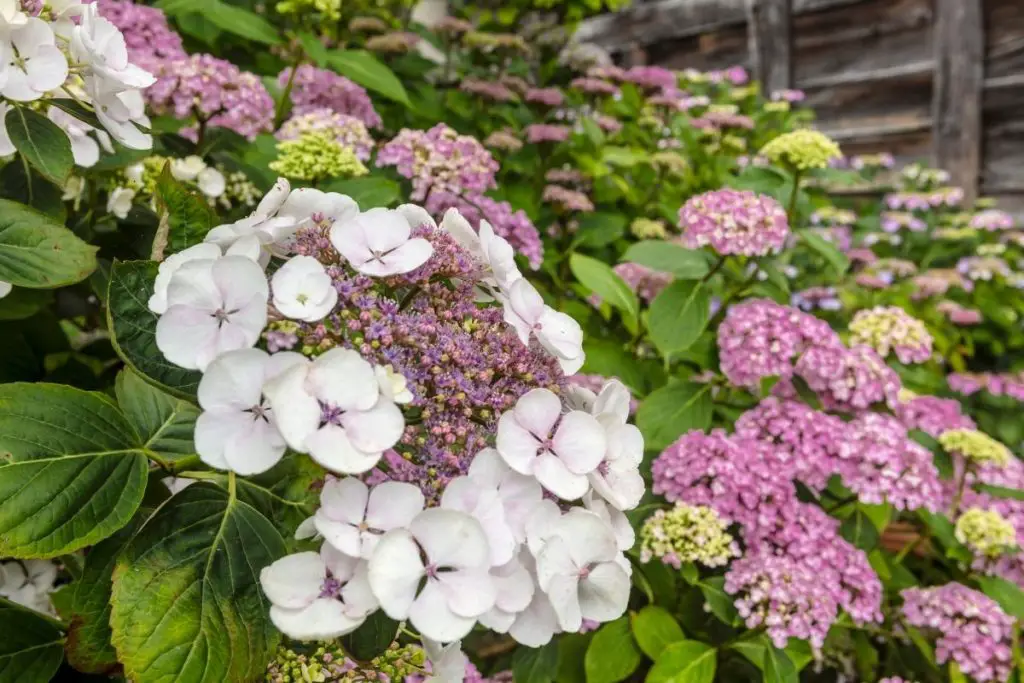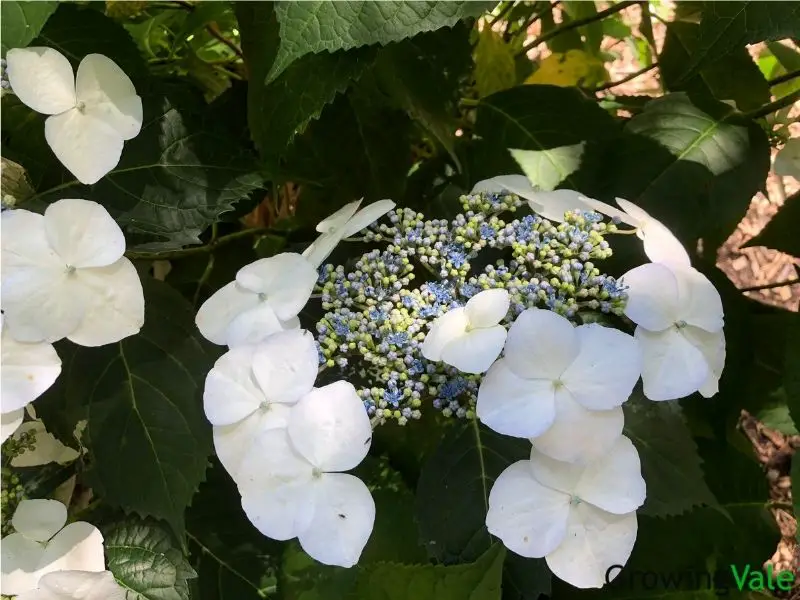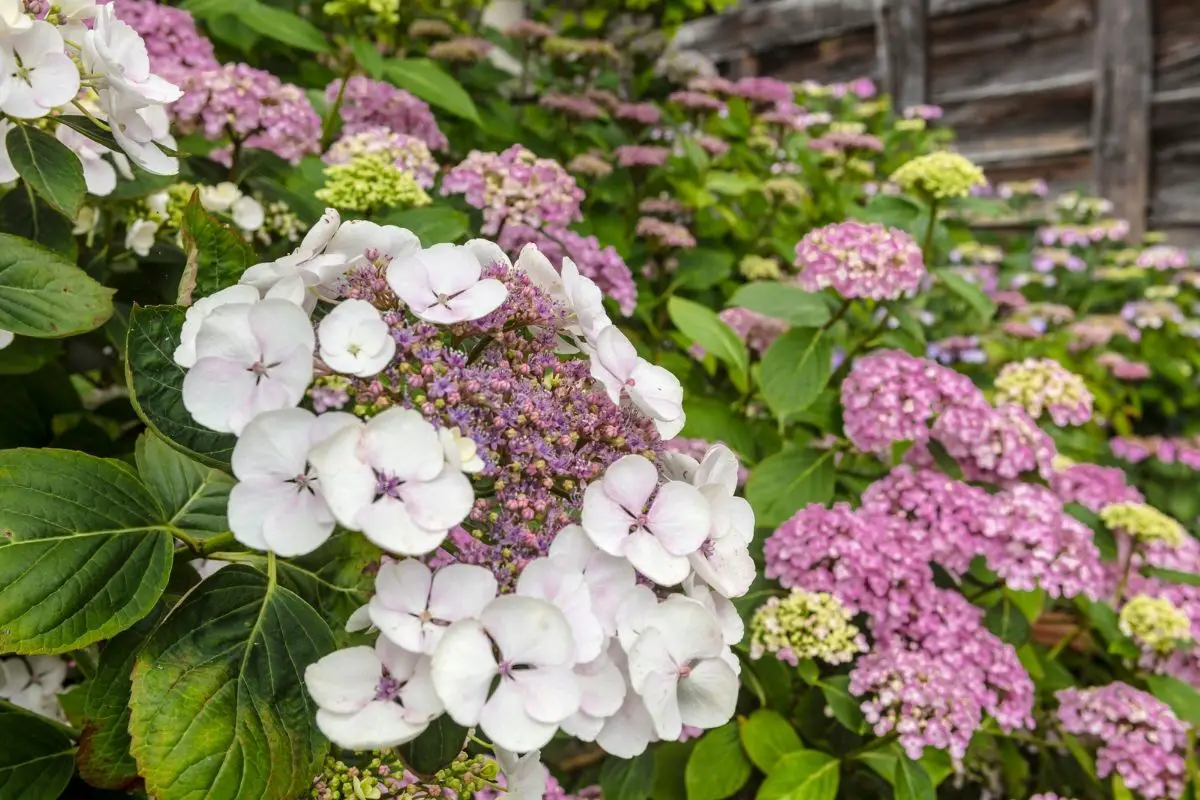The lacecap hydrangea shrub is an easy-to-grow perennial and produces a beautiful show of extravagant flowers during the summer. It is less well-known than the mophead hydrangea, but an equally lovely addition to your garden.
The mophead hydrangea produces clusters of rounded flowers, whereas the lacecap hydrangea blossoms are more delicate and flatter in form.
History
A lacecap hydrangea is, along with the mophead varieties, one of the Hydrangea macrophylla cultivars. Lacecap hydrangea bushes were introduced from Asia in the 1800s and bred in Europe during the early 1900s.
Plant Facts
| Scientific name | Hydrangea macrophylla ‘normalis’ |
| Common names | Lacecap hydrangea |
| Genus | Hydrangea |
| Family | Hydrangeaceae |
| Height | Up to 6 feet |
| Width | Up to 6 feet |
| USDA Plant Hardiness Zone | 5 to 9 |
| Native to | China, Japan |
| Blooming season | summer |
| Flower colors | Shades of pink, white, blue |
| Plant specific features | Flat clusters of flowers with lacy edges |
How to Plant and Grow Lacecap Hydrangeas
The lacecap hydrangea (H. macrophylla) is an easy-to-grow plant that is native to Japan. Provided it is given the right growing environment, this bush will reward you, year after year, with a spectacular show of brightly colored blooms.
The best place to plant your hydrangea shrub is in the ground, in a position where it will receive some sunlight but also be protected from the heat of the afternoon sun in the summer.
If space is limited, you may choose to use a container in which to plant your lacecap hydrangea. A pot does have the advantage of being movable, so you can adjust its position to protect it from getting too much heat or sunshine. The disadvantage is that pots tend to dry out more than the ground, so watering needs to be more frequent so that your plant’s roots maintain adequate moisture levels.
Nurseries sometimes produce lacecap hydrangea plants as pot plants for indoor use. These are often not intended for long-term use and may have been treated with growth inhibitors to keep them small and compact. Their flowers may have been forced, and it may not be possible to transplant one of these houseplants outside.
Plant your lace cap hydrangeas either in the fall or in the spring. Always avoid planting in extreme weather conditions, such as the winter or the summer.

How to Propagate Lacecap Hydrangeas
Lacecap hydrangeas are easy to grow and every year they will reward you with their colorful blooms. There are two main ways to take cuttings and increase the number of your plants.
Since many hydrangeas have low-lying branches, it is easy to peg one of these directly to the soil in the ground. After a few months, roots will have formed, and you can separate the rooted cutting from the main plant. You can grow this layered hydrangea cutting in a pot, or directly in the soil.
Alternatively, you can take a cutting from the new growth in spring and propagate the hydrangea shrub in this way. The best way to do this is to cut about 2 inches under an unbudded leaf node. Make sure the branch you have chosen is healthy and strong.
Remove all the leaves apart from the top pair and don’t damage the stem. The two leaves you have retained should be sliced in half, the stem should then be dipped in hormone rooting powder and the cutting is ready to pot up.
For the first few weeks, you can leave around six stem cuttings in the same pot. But once roots have formed, each new hydrangea shrub should have its own pot.

Lacecap Hydrangea Care and Maintenance
To get the best from your lacecap hydrangeas, you should provide the plants with favorable growing conditions and care.
Soil
As with all H. macrophylla varieties, the lacecap hydrangea plant should ideally have rich, well-drained soil in which to grow. Fortunately, the hydrangea isn’t a plant that is too fussy, and it will grow in most soils with adequate drainage. But for the best flowers, the soil should be slightly acidic (with a pH value between 5 and 7).
The more acidic the soil, the bluer the flower’s color becomes. If you wish to have pink flowers, you can increase the soil pH to over 7. Increased alkalinity will result in pinker flowers. This will not be applicable if your lacecap hydrangea has white flowers. White hydrangea blooms will always be white, whatever the pH level of your soil.
Water
One of the essential requirements for growing good hydrangeas is the supply of an adequate provision of water. Hydrangea shrubs will not survive if their roots are left in waterlogged soil, which is why well-drained soil is essential.
A hydrangea planted in a spot that receives a lot of sun, heat, or wind will dry out quicker and require more water than one that is protected from wind and planted in partial shade.
A lacecap hydrangea plant is always best watered at its base around its roots; ideally, you should avoid watering its foliage or blooms as the delicate flowers can become spoiled when wet.
Fertilizer
A specially designed fertilizer application made twice during the spring and early summer will encourage a plentiful supply of flowers. This is how to make hydrangeas bloom.
You can use either slow-release chemical fertilizer or organic mulch, the latter of which will give you the added advantage of conditioning the soil.
You shouldn’t apply fertilizer after August, because you don’t want to encourage new, tender growth at this stage of the season which may not survive the winter.
Sunlight
A lacecap hydrangea isn’t a fussy plant. However, to get the best flowers, you should provide a site that receives some sunshine in the mornings and is protected from the heat of the sun in the afternoons.
Frequently, hydrangea shrubs are planted in woodland settings with dappled shade. If your lacecap bush isn’t flowering well, it is perhaps because it isn’t getting enough sunlight.
Humidity and Temperature
H. macrophylla does not like to sit in muddy, waterlogged soil and will die if its roots are left in saturated ground for too long. But equally, it needs plenty of water because of its large leaves and abundance of large blooms! The easiest way to check whether your hydrangea needs water is to let it dry out between watering and only water when the top inch of soil is dry.
One of the reasons that hydrangea bushes are frequently planted in dappled shade is because they will wilt if they get too much heat in the middle of the summer.
They are happiest if they get some sunshine at the cooler times of the day. You will also find the shrubs will really come into their own once temperatures start to cool down in late summer/early fall.
Pruning
Lacecap hydrangeas are, like the mopheads, a hydrangea variety that flowers on old wood. They are relatively hardy and should be pruned as soon as flowering has finished. This gives new shoots time to develop before the plant goes into winter dormancy.
Pruning at this stage incorporates removing the faded flowers. This will stop the plant from using its energy to produce unwanted seeds. You should also remove any straggly branches that are lying on the ground unless you intend to use them for propagation by layering.
If a late spring frost causes any damage to your lacecap hydrangea bushes, you should cut back the damage to the first pair of undamaged buds.
Pest and diseases
If your lacecap hydrangea plant is subjected to prolonged spells of cold, damp weather, then it is prone to develop a fungal disease such as mildew or blight. This can damage the flowers and diseased spores can spread to other parts of the plant through the wind.
As for other pests, most will only cause superficial damage and not adversely impact the plant’s health.
Uses for Lacecap Hydrangeas
If you love hydrangeas, but find the big, blousy blooms of the mopheads a little too overbearing, then you should consider growing a lacecap hydrangea shrub instead. This combines the beauty of the mophead but is a little more dainty. The main difference is the flower shape and overall appearance, which has elegance all of its own.
There is one more great advantage if you live in a climate that is a little cooler. The lacecap is hardier and less prone to frost damage in the spring.
Common Varieties and Cultivars
You can choose from numerous types of hydrangeas depending on the size and color you want. You won’t be disappointed as these shrubs will blend into any setting and provide a colorful show.
Pink, blue or white flowers are available, some of which will also provide interesting colored foliage in the fall.
If you are looking for a dwarf hydrangea plant, then you can choose a compact cultivar such as Mount Aso, which can also be grown as ground cover. A variety such as this will only grow to about 2 feet in height. Other cultivars such as the Villosa hydrangea shrub (H. aspera) will grow and spread to over 10 feet.
Some popular lacecap varieties from which to choose are:
- Hydrangea serrata “Blue Deckle” – dwarf lacecap which will grow to around 3 ½ feet. An ideal choice for smaller spaces and providing additional color with a fall foliage display.
- Lanarth White – tough and a good choice for exposed, coastal sites, growing to about 5 ½ feet in height and spread,
- Zorro – a vigorously growing plant, reaching around 5 ½ feet in height and spread. Very showy flowers.
- Lady in Red – very compact, only growing to around 2 feet, can be pink or blue and in fall, the foliage turns a deep purple.
- H. aspera spp sargentiana – needs plenty of space to expand as it will grow to 10 feet in height and width. This variety has pretty flowers and soft leaves.
- H. aspera (Villosa) – produce delicate purple-blue flowers whatever the pH of the soil. Has soft and interesting foliage and flowers a little later. Grows large, to around 10 feet in height and width.
- Jogasaki – a medium-sized plant with pretty flowers which form a lacy ring around the center. This cultivar can range in color from pink to blue depending upon the pH levels of the soil.
- Veitchii – growing to around 5 feet in height and spread, this is a well-known, white-flowered lacecap that will never fail to delight when planted in a mixed herbaceous flower border.
- Irish Lace – a white variety, which has been nicknamed the “garland hydrangea” due to the arching effect of its flowers.
- Twist-n-Shout – a large lacecap that can flower blue or pink. Twist–n-Shout provides a double display as it blooms both in the spring and fall.
- Cherry Explosion – this hydrangea will flower pink even at different pH levels.
Conclusion
Lacecap hydrangea bushes are the wild types of hydrangea. Whilst Japanese gardeners did select certain lacecaps for landscaping purposes, the mopheads overtook the lacecaps in the popularity stakes. Even today, many people haven’t seen a lacecap hydrangea shrub, even though the white “Veitchii” variety is famous and dates back over a century.
The lacecaps have much to offer the gardener, not least because of their hardiness. Over the last ten years, it is great to see that many plant breeders have started to turn their attention to developing more varieties of lacecap hydrangeas and Cherry Explosion is one such exciting example.
~ image source: depositphotos/Debu55y

